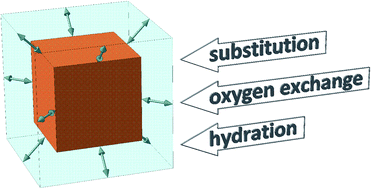Chemical lattice strain in nonstoichiometric oxides: an overview†
Abstract
Strong coupling between the chemical composition and crystal lattice dimensions resulting in the contraction or expansion of a material upon change of its chemical composition is known as chemical expansion or chemical strain. This phenomenon significantly influences the performance of oxide materials in different energy conversion and storage devices. In many such applications, e.g., in oxygen-permeating membranes or solid oxide fuel cells (SOFCs), the materials are subject to significant in situ variation of their chemical composition, which is accompanied by large volume changes. This may often be detrimental to the operation of the electrochemical device. Not only is chemo-mechanical coupling crucial for various practical applications, but also, when measured accurately and discussed appropriately, the chemical strain of an oxide material allows better understanding of its local electronic and defect structure. Chemical strain is also strongly correlated with diffusion phenomena in high-temperature electrochemical devices – the subject that for many years has been of particular scientific interest for John Kilner and where he holds a lot of pioneering achievements. This article reviews the state of the art in the field of chemical strain of various oxide materials, primarily those intended to operate at elevated temperatures, and aims at summarizing the available experimental, theoretical and computational insights into its origins, factors impacting its magnitude, and the available means for its a priori quantitative estimation.

- This article is part of the themed collection: Special issue in honour of Prof. John Kilner’s 75th birthday


 Please wait while we load your content...
Please wait while we load your content...